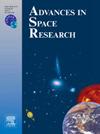行星际冲击对一氧化氮冷却排放的影响:叠加纪元研究
IF 2.8
3区 地球科学
Q2 ASTRONOMY & ASTROPHYSICS
引用次数: 0
摘要
研究了在地磁静止期间行星际(IP)冲击对一氧化氮(NO)5.3 微米冷却发射的影响。主动磁层和行星电动力学响应实验测量到的场对准电流在 IP 震荡期间加剧,南半球的幅度相对高于北半球。国防气象卫星计划航天器的观测结果表明,能量小于 1 千伏的沉淀粒子通量会在早期强烈增强。较高能量的粒子通量在较晚的时间才出现反应。由于低能量粒子的沉降,氮氧化物密度在事件发生前显著增加了一个数量级。400 公里处的热层温度上升了约 100 K。叠加历时分析研究表明,由于 IP 冲击引发的粒子降水和热层温度迅速上升,TIMED(热层电离层中间层能量动力学)卫星上的 SABER(利用宽带发射辐射测量法探测大气层)对 NO 冷却发射的测量结果呈线性增强。本文章由计算机程序翻译,如有差异,请以英文原文为准。
Impact of interplanetary shock on nitric oxide cooling emission: A superposed epoch study
The impact of interplanetary (IP) shock on Nitric Oxide (NO) 5.3 µm cooling emission is studied during geomagnetic quiet periods. The Active Magnetosphere and Planetary Electrodynamics Response Experiment measurements of field-aligned-currents intensify during IP shock with a relatively higher magnitude in southern hemisphere as compared to the northern hemispheric counterpart. The Defense Meteorological Satellite Program spacecraft observations displayed an early and strong enhancement in the precipitating particle flux of energy less than 1 keV. The particle flux of higher energy responds at later time. The NO density exhibited a significant, pre-event increase by an order of magnitude due to low-energy particle precipitation. The thermospheric temperature increased by about 100 K at 400 km. The superposed epoch analysis study revealed a linear enhancement in SABER (Sounding of the Atmosphere using Broadband Emission Radiometry) measurements of NO cooling emission onboard the TIMED (Thermosphere Ionosphere Mesosphere Energetics Dynamics) satellite due to the prompt increase in particle precipitations and thermospheric temperature triggered by IP shock.
求助全文
通过发布文献求助,成功后即可免费获取论文全文。
去求助
来源期刊

Advances in Space Research
地学天文-地球科学综合
CiteScore
5.20
自引率
11.50%
发文量
800
审稿时长
5.8 months
期刊介绍:
The COSPAR publication Advances in Space Research (ASR) is an open journal covering all areas of space research including: space studies of the Earth''s surface, meteorology, climate, the Earth-Moon system, planets and small bodies of the solar system, upper atmospheres, ionospheres and magnetospheres of the Earth and planets including reference atmospheres, space plasmas in the solar system, astrophysics from space, materials sciences in space, fundamental physics in space, space debris, space weather, Earth observations of space phenomena, etc.
NB: Please note that manuscripts related to life sciences as related to space are no more accepted for submission to Advances in Space Research. Such manuscripts should now be submitted to the new COSPAR Journal Life Sciences in Space Research (LSSR).
All submissions are reviewed by two scientists in the field. COSPAR is an interdisciplinary scientific organization concerned with the progress of space research on an international scale. Operating under the rules of ICSU, COSPAR ignores political considerations and considers all questions solely from the scientific viewpoint.
 求助内容:
求助内容: 应助结果提醒方式:
应助结果提醒方式:


